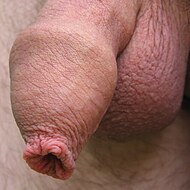
Back Voorhuid Afrikaans Prepucio AN قلفة Arabic Vorhaut BAR Lusi BCL Крайняя плоць Byelorussian Крайняя плоць BE-X-OLD Препуциум Bulgarian লিঙ্গত্বক Bengali/Bangla Pod-mezenn Breton
| Foreskin | |
|---|---|
 Human foreskin fully covering the glans penis | |
| Details | |
| Precursor | Genital tubercle, urogenital folds |
| System | Male reproductive system |
| Artery | Dorsal artery of the penis |
| Vein | Dorsal veins of the penis |
| Nerve | Dorsal nerve of the penis |
| Identifiers | |
| Latin | praeputium, preputium penis[1] |
| MeSH | D052816 |
| TA98 | A09.4.01.011 |
| TA2 | 3675 |
| FMA | 19639 |
| Anatomical terminology | |
In male human anatomy, the foreskin, also known as the prepuce (/ˈpriːpjuːs/), is the double-layered fold of skin, mucosal and muscular tissue at the distal end of the human penis that covers the glans and the urinary meatus.[2] The foreskin is attached to the glans by an elastic band of tissue, known as the frenulum.[3] The outer skin of the foreskin meets with the inner preputial mucosa at the area of the mucocutaneous junction.[4] The foreskin is mobile, fairly stretchable and sustains the glans in a moist environment.[5] Except for humans, a similar structure known as a penile sheath appears in the male sexual organs of all primates and the vast majority of mammals.[6]
In humans, foreskin length varies widely and coverage of the glans in a flaccid and erect state can also vary.[7] The foreskin is fused to the glans at birth and is generally not retractable in infancy and early childhood.[8] Inability to retract the foreskin in childhood should not be considered a problem unless there are other symptoms.[9] Retraction of the foreskin is not recommended until it loosens from the glans before or during puberty.[9] In adults, it is typically retractable over the glans, given normal development.[9] The male prepuce is anatomically homologous to the clitoral hood in females.[10][11] In some cases, the foreskin may become subject to a pathological condition.[a][12]
- ^ Paulsen, Friedrich; Waschke, Jens (2023). Sobotta Atlas of Anatomy, Vol. 2, 17th Ed., English/Latin: Internal Organs. Elsevier Health Sciences. p. 2971. ISBN 978-0-70206-770-9. Retrieved October 11, 2023.
- ^ Kirby R, Carson C, Kirby M (2009). Men's Health (3rd ed.). New York: Informa Healthcare. p. 283. ISBN 978-1-4398-0807-8. OCLC 314774041.
- ^ Male circumcision : global trends and determinants of prevalence, safety, and acceptability. Helen Weiss, World Health Organization, Joint United Nations Programme on HIV/AIDS, London School of Hygiene and Tropical Medicine. Geneva: World Health Organization. 2008. ISBN 978-92-4-159616-9. OCLC 425961131.
The foreskin is attached to the glans by the frenulum
{{cite book}}: CS1 maint: others (link) - ^ Raynor, Stephen C. (2010-01-01), Holcomb, George Whitfield; Murphy, J. Patrick; Ostlie, Daniel J. (eds.), "chapter 61 - CIRCUMCISION", Ashcraft's Pediatric Surgery (Fifth Edition), Philadelphia: W.B. Saunders, pp. 791–795, ISBN 978-1-4160-6127-4, retrieved 2022-10-24,
The prepuce is a specialized junctional mucocutaneous tissue that provides adequate skin and mucosa
- ^ Collier, Roger (2011-11-22). "Vital or vestigial? The foreskin has its fans and foes". Canadian Medical Association Journal. 183 (17): 1963–1964. doi:10.1503/cmaj.109-4014. ISSN 0820-3946. PMC 3225416. PMID 22025652.
It is also a warm, moist environment that may allow viral particles to linger longer on the penis
- ^ Fahmy, Mohamed A. Baky (2015), Fahmy, Mohamed A. Baky (ed.), "Prepuce", Rare Congenital Genitourinary Anomalies: An Illustrated Reference Guide, Berlin, Heidelberg: Springer, pp. 33–41, doi:10.1007/978-3-662-43680-6_3, ISBN 978-3-662-43680-6, retrieved 2022-12-01
- ^ Cite error: The named reference
pmid9734426was invoked but never defined (see the help page). - ^ Dave, Sumit; Afshar, Kourosh; Braga, Luis H.; Anderson, Peter (2018). "CUA guideline on the care of the normal foreskin and neonatal circumcision in Canadian infants". Canadian Urological Association Journal. 12 (2): E76 – E99. doi:10.5489/cuaj.5033. ISSN 1920-1214. PMC 5937400. PMID 29381458.
At birth, the inner foreskin is usually fused to the glans penis and should not be forcibly retracted
- ^ a b c Potts, Jeannette (2004). "Penis Problems". Essential Urology: A Guide to Clinical Practice. Humana Press. p. 29. ISBN 9781592597376.
Virtually all foreskins become retractable in puberty. Thus, phimosis is not a pathological condition in young children unless it is associated with balanitis, or, rarely, urinary retention.
- ^ Crooks, Robert L.; Baur, Karla (2010-01-01). Our Sexuality. Cengage Learning. ISBN 978-0-495-81294-4.
- ^ Sloane, Ethel (2002). Biology of Women. Delmar Thomson Learning. ISBN 978-0-7668-1142-3.
- ^ Shah M (January 2008). The Male Genitalia: A Clinician's Guide to Skin Problems and Sexually Transmitted Infections. Radcliffe Publishing. pp. 37–. ISBN 978-1-84619-040-7. Archived from the original on 2016-02-01. Retrieved 2015-10-27.
Cite error: There are <ref group=lower-alpha> tags or {{efn}} templates on this page, but the references will not show without a {{reflist|group=lower-alpha}} template or {{notelist}} template (see the help page).